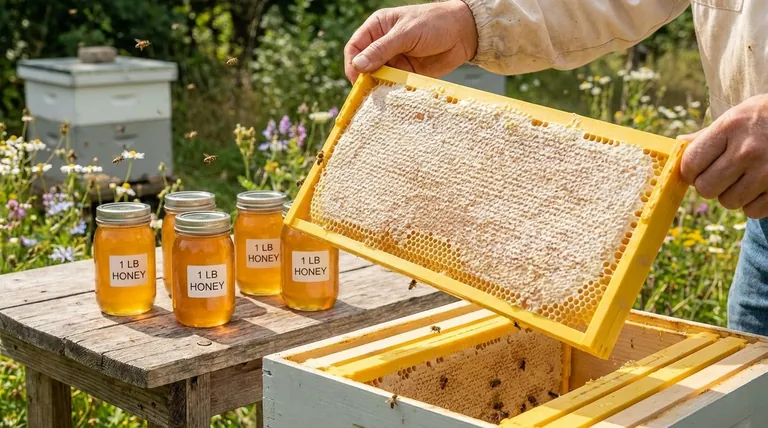On average, a single, fully capped frame of honey will yield between three to five jars. A standard medium frame typically produces around 4 pounds of honey, which translates directly to four 1-lb jars. Some reports indicate a yield as high as six or seven jars per frame, though this often depends on a larger frame size or smaller jar volume.
The question isn't just about a single number, but about understanding the variables that produce that number. Frame size, bee health, and nectar availability are the true determinants of your honey yield, and mastering them is the key to a successful harvest.

The Key Factors That Determine Your Yield
A beehive is a dynamic biological system, not a factory. The amount of honey you can harvest from a single frame is never fixed. Several critical factors come into play, and understanding them will help you manage expectations and improve your results.
Frame Size: The Foundational Variable
Not all frames are created equal. Beekeepers use different sizes for different parts of the hive, which directly impacts the potential honey volume. While there are many types, the most common are Deep, Medium, and Shallow. Honey is typically harvested from Medium frames, which are easier to handle when full.
Colony Strength and Health
A strong, populous colony with a healthy queen will have a large workforce of forager bees. More foragers mean more nectar can be collected during peak times, leading to a much faster and larger honey surplus. A weaker hive will consume most of the nectar it gathers just to survive.
Nectar Flow and Environment
The single biggest external factor is the nectar flow. This is the period when flowers in your local environment are producing abundant nectar. A strong, consistent nectar flow fueled by good weather and healthy plant life is essential for a large honey harvest. A drought or unseasonable cold can stop a nectar flow in its tracks.
How "Capped" Honey Affects Weight
Bees cap honey cells with beeswax once the honey has been dehydrated to the correct moisture content (around 18%). A fully capped frame is ready for harvest and contains dense, heavy honey. Harvesting an uncapped frame yields honey with higher water content, which is lighter and risks fermentation.
Understanding the Trade-offs
Your approach to harvesting is as important as the conditions in the hive. Your goals will determine when and how much you take.
The Goal of a Full Harvest
To get the maximum yield of 3-5 pounds per frame, you must wait until the frame is at least 80% capped with beeswax. This ensures the honey is ripe and at its maximum density and weight. This approach requires patience but delivers the best quantity.
The Benefit of Partial Harvesting
You do not have to take an entire frame at once. Modern hives, like the Flow Hive mentioned in the references, make it easy to drain a small amount of honey, such as a single jar's worth. This method is excellent for leaving plenty of resources for the bees, reducing disruption to the colony, and enjoying fresh honey throughout the season.
How to Apply This to Your Project
Your final yield comes down to your goals and methods. Use these principles as a guide for planning your beekeeping activities.
- If your primary focus is planning for equipment: Use a conservative estimate of 3 pounds (or three 1-lb jars) per medium frame when calculating how many jars and labels to purchase.
- If your primary focus is maximizing your honey yield: Ensure your colonies are strong heading into the main nectar flow and wait for frames to be fully capped before you harvest.
- If your primary focus is hobby beekeeping and bee health: Prioritize leaving enough honey for the bees, harvesting only from truly surplus frames, and consider partial harvests to minimize stress on the colony.
Ultimately, understanding these core factors empowers you to move from guessing toward a predictable and sustainable honey harvest.
Summary Table:
| Factor | Impact on Honey Yield |
|---|---|
| Frame Size | Medium frames are standard; larger frames can yield more. |
| Colony Health | Strong, healthy colonies produce a larger honey surplus. |
| Nectar Flow | Abundant local flora and good weather are essential for a good harvest. |
| Capped Honey | Fully capped frames yield denser, heavier honey ready for harvest. |
Ready to equip your apiary for a successful season?
Whether you're a commercial beekeeper managing hundreds of hives or a distributor supplying the beekeeping community, the right equipment is foundational to maximizing honey production. HONESTBEE supplies durable, high-quality beekeeping supplies and equipment through wholesale-focused operations, helping you build stronger colonies and achieve more predictable harvests.
Contact our team today to discuss your specific needs and explore our wholesale catalog. Let's help you build a more productive and profitable operation.
Visual Guide

Related Products
- Plastic Honey Comb Frames Cassette Box for Honey
- Heart-Shaped Comb Honey Frame and Honeycomb Cassette
- Professional In-Hive Bee Feeder HONESTBEE Frame for Beekeeping
- Plastic Bee Frame Beekeeping Hive Frames for Wholesale
- Stainless Steel 9 Frame Hive Spacer Durable Precise for Commercial Beekeeping
People Also Ask
- How do honeybees generate heat during winter? The Superorganism's Survival Strategy
- What is the bee hive shape called? The Hexagon's Role in Nature's Perfect Storage System
- What is a benefit of storing honey-laden frames? A Strategic Food Source for Spring Colony Survival
- Can beekeepers switch between wooden and plastic frames? Optimize Your Hive's Performance
- What frame to use for honeycomb? Choose the Right System for Pure, Edible Comb



















